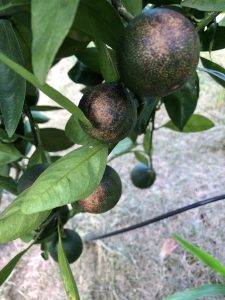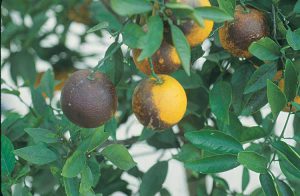
“Sharkskin Damage” to fruit caused by past feeding by the Citrus Rust Mite. Image Credit, Matthew Orwat
In recent years, not a summer has gone by in which I did not see citrus rust mite (CRM) damage in a citrus grove. I thought this year would be the first. Unfortunately, last week I saw my first rust mite damage of the year.
Unlike the myriad of pests that have been recently introduced into Florida from abroad, the citrus rust mite (Phyllocoptruta oleivora) has been documented as present in Florida since the late 1800s. Along with its companion, pink citrus rust mite (Aculops pelekassi) It can be a major summer pest for satsuma mandarins grown in the Florida Panhandle region for fresh market sales.
Citrus Rust Mite (CRM) damage manifests itself on fruit in two ways, “sharkskin” and “bronzing“. Sharkskin is caused when mites have fed on developing fruit, and destroyed the top epidermal layer. As the fruit grows, the epidermal layer breaks and as the fruit heals, the brown “sharkskin” look develops. Bronzing occurs when rust mites feed on fruit that’s nearer to mature size. Since the skin is not fractured by growth, the fruits develop a polished bronze look. In both cases, the interior of the fruit may remain undamaged. However, extreme damage can cases cause fruit drop and reduced fruit size. Regardless of the condition of the interior, damaged fruit is unmarketable for fresh fruit sales.
It is important to monitor citrus groves for CRM April to October. Some specifics for the monitoring procedure are described in this quote from a Featured Creatures publication.
It is suggested to sample a 10 to 40-acre block by checking 20 trees at random (Qureshi and Stansly 2019). One fruit, located midway in the canopy, is chosen from each of the four quadrants of the trees. The number of rust mites per square centimeter is recorded. Phyllocoptruta oleivora has a rapid growth capacity and a short generation time during summer. Therefore, it is important to monitor the populations every 2 to 3 weeks once detected and plan spray treatments following a threshold of 2 mites/cm2 for fresh fruit and 6-10 mites/cm2 for processed fruit (Qureshi and Stansly 2019).

Sun spot resulting from where citrus rust mite avoids feeding on most sun exposed portion of the fruit. Image and Caption courtesy of EDIs publication HS-806
If a CRM population is present, they will begin increasing on fresh spring new growth in late April, and usually reach peak levels in June and July. By August the damage has often already been done, but is first noticed due to the increased growth of the fruit. Depending upon weather conditions, CRM can have a resurgence in October and November, just as Satsuma and other citrus is getting ready to be harvested, so careful monitoring is necessary. For more information, check out this publication: Guide to Citrus Rust Mite Identification.
If control of CRM is warranted, there are several miticides available for use. Care must be taken to monitor and only treat when necessary, since application of miticides will reduce the population of beneficial predatory insects. This reduction of insect predators could cause an increase in other harmful insects, such as aphids and leafminers. Horticultural oil is an alternative to miticides, which is less damaging to beneficial insects. Several brands of horticultural oil are formulated to smother CRM, but care must be taken to not apply horticultural oil when daytime temperatures will reach 94 degrees Fahrenheit. Application of oils at times when temperatures are at this level or higher will result in leaf and fruit damage.
The 2019-2020 Florida Citrus Production Guide has a great chapter on CRM control, and lists a table with different miticide options. To reduce the likelihood of pesticide resistance, never use a single type of miticide more than once a season.
Although Citrus Rust Mite (CRM) has the potential to be damaging to fresh market citrus fruit in the Florida Panhandle, strategies of monitoring and treatment in commercial and homeowner citrus production have been successful in mitigating their damage.
- Steps to Remedy Non-Productive Pecan Orchards - June 30, 2023
- If Not Disease, Then What? Abiotic Vegetable Disorders - June 24, 2022
- Dormant Sprays Protect Fruit Trees from Future Insects and Diseases - January 28, 2022
